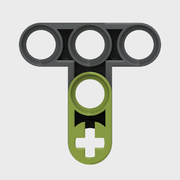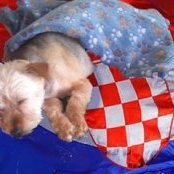Search the Community
Showing results for tags 'john deere'.
Found 5 results
-

[MOC] John Deere SESAM 2 tractor
MP LEGO Technic creations posted a topic in LEGO Technic, Mindstorms, Model Team and Scale Modeling
It might seem that the field of agriculture is not much affected by the boom of modern technologies, but it is precisely in agriculture that a rapid development of automation and robotization is expected not only in the processing of crops, but also in their cultivation. For this reason I have decided to build something different this time - namely an official autonomous concept of a John Deere tractor called SESAM 2. This one differs from other visions in particular by the possibility of attaching the driver's cabin and the ability to work both in a purely autonomous mode or be remotely/directly controlled from its cabin. In the field, the cab can be detached at the headland, allowing the operator to monitor and possibly control the tractor. The efficiency is further increased by the ability to work in a swarm, so it is possible to monitor or control several machines working in the same field from one cabin. Since the real tractor has a power of 500kW, I decided not to use just one motor to drive it, but two. In terms of shape, the so-called large angular motor is suitable for the model of this particular tractor, because it enables better use of space - i.e. the possibility of placing it vertically on both sides of the chassis between the axles, thereby freeing up space in the center of the model, which can subsequently be used for other functions. A central differential is usually used to compensate for the difference in wheel speeds of the front and rear axles due to their different diameters, however the disadvantage of this variant is that if one of the wheels of the front axle is not in contact with the ground, all the power of the drive system will go to this wheel and the model will stop. By inserting suitable gears, the speed difference will be equalized, so it is possible to replace the central differential with a fixed connection of the drive shafts of both axles. Thanks to the drive motors located on the sides of the central frame, it is possible to add a mechanical locking rear differential working on the basis of a centrifugal regulator in conjunction with another differential used to compare the revolutions of individual wheels (note: each of the output shafts of the drive differential is connected to the output shafts of the "control differential", but one of them utilizes higher number of gear wheels, so when both shafts of the drive differential are at the same speed, the "control differential" does not move) of the rear axle - if the difference in the speed of the two wheels is too high, this differential connected to the centrifugal regulator also turns, with a higher centrifugal force with the arms of this regulator will begin to lift until they are far enough away from each other that the surrounding parts prevent them from further moving away, thereby blocking the entire regulator. This will stop the "control rear differential" from rotating and close the drive differential. CREDIT goes to @JoKo, I just loved his brilliant idea so much that I decided to build a model around it My original design of steering included a gear rack, but it turned out to be inaccurate in practice, and the range of the wheels was greatly limited. Therefore, it was necessary to come up with a new concept - control of the steering connecting rod using a small LA. This solution is features in particular a higher force for controlling the wheels with a reduced engine load, greater steering angle, improved accuracy and protection of the motor in extreme positions thanks to the internal safety element of the used LA. In addition, the entire axle is pendular to achieve better offroad ability. The only pneumatic circuit uses a classic pump+switch combo: A Medium angular motor is used for the rear PTO. Since a variety of implements can be attached to the tractor and there is no space left to build in any speed gearbox I have decided to use not one, but two coupled PTO outputs, which differ from each other in their speeds. The front hydraulics is driven by another Medium angular motor, and sufficient load capacity is ensured by a worm gear. Similar to the front three-point hitch, the rear hydraulics use a worm gear, with the Angular motor replaced by a more powerful Control+ L motor, as heavier equipment is attached to the rear. When talking about lighting - John Deere is based in the US, where red turn signals are common, so it is possible to use the same LEDs for both tail lights and turn signals. Blinking is solved by software changing the intensity, where the direction lights flash in short time intervals with 100% intensity, while the rear lights only shine at half power. A small addition are two glow-in-the-dark stripes on both sides of the machine, which do not require any electric connection. All "autonomous" features are in fact a mere Mindstorms distance sensor. Schematic layout of mechanical functions: Schematic layout of the mechanical functions, including the respective motors (both HUBs are located above the front axle, due to which it is heavily loaded and, together with the powerful drive system, ensure exceptional traction capabilities): Complete tractor chassis: At first glance, it might seem that the shape of the selected tractor is simpler than that of classic tractors, but upon closer observation it becomes clear that even apparently flat surfaces are curved, slanted or otherwise modified. Designing the model is also greatly hampered by the lack of visual material. All searchable photos are just a snapshot of a certain part of a not-so-long video. This video, along with the minimal amount of information published, is the only source from which the LEGO model was designed. The chassis of the production 6R series tractor gave a slight idea of the dimensions, but the body design was purely based on my own experience. Since the cabin will often stand on the ground, I came up with the idea of equipping it with rubber pads, which not only dampen the impact when it is placed, but also provide it with better stability even on uneven surfaces due to higher friction. The interior is equipped with small details, such as an adjustable steering wheel collumn and armrest or a lockable storage space under the folding passenger seat. Various devices can of course be attached to this tractor - here is, for example, Rolland Rollspeed 7136 trailer: To the controlling app - on a mobile device (tablet) the Mindstorms application will be directly connected to one of two HUBs in the model, which will directly control the motors connected to this HUB, while on the other HUB a stored program will be run waiting for the start signals that will be forwarded to it from tablet through the first HUB and their mutual (HUB-to-HUB) communication. And for more convenient control, I also used the Sony Dualshock 4 game controller. Program streamed to HUB 1: 1) Control of rear and direction lights 2) Front axle steering 3) Sending a signal for HUB 2 - turning on the front lights with the brightness value "light brightness" (14) 4) Setting the value of the "sensor" variable needed for its activation/deactivation 5) Forward/backward control along with obstacle detection and emergency stop (15) 6) Sending a signal for HUB 2 – starting the PTO in one way 7) Sending a signal for HUB 2 – starting the PTO in the other way 8) Sending a signal for HUB 2 – starting the pump in one way 9) Sending a signal for HUB 2 – starting the pump in the other way 10) Sending a signal for HUB 2 - lowering the front three-point hitch 11) Sending a signal for HUB 2 – raising the front three-point hitch 12) Sending a signal for HUB 2 - lowering the rear three-point hitch 13) Sending a signal for HUB 2 – raising the rear three-point hitch 14) Setting the value of the "brightness of the lights" variable needed to turn them on/off 15) Setting the value of the "stop" variable for turning on/off the emergency brake Program stored in HUB 2: 1) Signal reception from HUB 1 – turning on/off the front lights 2) Signal reception from HUB 1 – lowering/raising the front three-point hitch 3) Signal reception from HUB 1 – lowering/raising the rear three-point hitch 4) Receiving a signal from HUB 1 – starting the PTO in one or the other direction 5) Receiving a signal from HUB 1 – starting the pump in one direction or the other Some dimensions: Length (without cab/with cab): 360mm/445mm Width (without cabin/with cabin): 180 mm/225 mm Height (without antennas/with antennas): 184 mm/218 mm Wheelbase: 160 mm Wheel track (front/rear axle): 136 mm/136 mm Weight: 2660 g (Without cabin); 3035 g (With cabin) Proportional axle load: Front - 55%; rear - 45% Load capacity of three-point hitches: Front - 626 g; Rear - 565 g (well, that's definitely interesting ) The model consists of a total of 2950 original parts, while I managed to build in the following features: • all-wheel drive (2x Large Angular motor) • automatic rear differential lock • front axle steering (1x C+ L motor) • swinging front axle • front three-point hitch (1x Medium Angular motor) • rear three-point hitch (1x C+ L motor) • auxiliary drive of implements (1x Medium Angular motor) • pneumatic drive of external devices (1x C+ L motor) • front and rear lighting (4 pairs of LED lights) • obstacle detection and automatic braking systém (Distance sensor) • remotely detachable cab with movable interior details • robust bodywork with easy access to control units Link to WIP topic: I hope this post has not somehow exceeded the maximum allowed length or anything like that Thanks for visiting & comments are welcome!- 22 replies
-
- agriculture
- farm
-
(and 2 more)
Tagged with:
-

John Deere 8RX Tractor - 42168 alternate build with tracks
Timorzelorzworz posted a topic in LEGO Technic, Mindstorms, Model Team and Scale Modeling
Hello Community, I want to share a cool idea and model I came up with - using relative new 28T gears as sprockets for a tracked vehicle. When I first saw the inventory for the new 42168 John Deere 9700 Forage Harvester, I was impressed on how many gears are packed inside this small model so I decided to use as much as possible of them for a tracked Tractor. But can all that gears are used as sprockets for driving small tracks? Lets find it out. The new 28T gear fits literally perfect as sprocket and thanks to the soft tooths of that bevel gear, tracks are running surprisingly smooth. Every second tooth fits inside the gaps of the track links, where the other tooths fits inside the gaps of the track part itself and so on. With such a setup it might be possible to build a tracked vehicle and I tested alot on the tracks and the sprocket setup. Available gears from the 42168 Forage Harvester are not enough, so I decided to use the yellow gears only for the visible side of the model and to use other parts provided with the set to prevent the additional tracks from slipping... The model I ended up is a John Deere 8RX Tractor as alternate build for the 42168 John Deere Forage Harvester that requires 124 additional widely used track links (part 3873). Something odd, a model that requires additional tracks and let you the tires left over for some other cool stuff. The Tractor comes with steering and a working piston engine. Only parts from donor set 42168 are needed and all functions are working even without the additional track pieces. Lets take a look how smooth the tracks are running. The model is steered with wheel from the back (shown in blue) while the rear tracks are running the piston engine (shown in green) by driving the model smoothly over rough ground. Let the piston engine run by driving the tracks or by rotating the rear sprocket manually. Some impressions: If you like what you see and want to build your own John Deere 8RX Tractor Unit, feel free to support me on rebrickable. Happy Building. -

42136 - John Deere 9620R 4WD Tractor
Ngoc Nguyen posted a topic in LEGO Technic, Mindstorms, Model Team and Scale Modeling
From promobricks.de: Not too much is currently known to us about the 42136 set. In terms of price, the set will probably be 29.99 euros , we do not have a number of parts at the moment. We suspect that a John Deere 9R with a yellow tipping trailer could be hidden behind the set , but we are not quite sure yet. Set number: 42136 Designation: John Deere 9R Number of parts :? Release date: January 01, 2022? RRP: 29.99 euros -

[WIP] John Deere SESAM 2 + Rolland Rollspeed 7136
MP LEGO Technic creations posted a topic in LEGO Technic, Mindstorms, Model Team and Scale Modeling
I know that I shouldn't start another build before finishing all those previous ones but you know, when you get an idea, you sometimes just can't resist... Well, this time it's an electric tractor - John Deere SESAM 2 (Sustainable Energy Supply for Agricultural Machinery) because I've realized that it would be useful to have something to pull a trailer full of harvested "beets" from my ROPA harvester. I've decided to build this specific one because I wanted something that no one has built before (presumably) and I find this concept quite interesting as well. The problem I've faced from the very beginning is lack of any documentation - I can only build according to the video below (and photos that are mostly from this video). All I know is that it is based on a 6R tractor and its cabin comes from some kind of a harvester. The idea si that it can work as an autonomous tractor as well as a classic tractor (well, you can attach a cabin ) I also wanted to try designing a model in digital form before ordering all those expensive green parts This is where I got: Powered by 2 Mindstorms RI Hubs 7 motors (already placed), a distance sensor at the front and 4 pairs of lights (front, rear and indicators) 4WD with central differential and automatic rear diff lock (@JoKo will know ) by 2 Large Angular motors Steering via 1 C+ L motor Rear PTO (1 Medium angular motor) Front hydraulics (1 Medium angular motor) Rear hydraulic (1 C+ L motor) Sariel's pneumatic pump with switch for power output Pendular front axle First prototype of the front grille: Cabin: The internals: I know, it's already quite crammed inside but as I've already built it IRL, I'm really satisfied with the result! Everything seems to work well, the drivetrain is efficient (thanks to batteries at the front it can easily pull heavy objects) The only thing that isn't that fantastic is the diff lock (as many of you definitely spotted even in the beginning) - it works well, however it's only useful when one of the rear wheels is lifted off the ground. I can only pray that the front pendular axle will always copy terrain and have enough traction at anytimes I hope I'll manage to make a few photos of the real thing this week. Thank you for reading & comments with any suggestions are welcome as always!- 41 replies
-
- agriculture
- tractor
-
(and 2 more)
Tagged with:
-

WIP MOC John Deere R4038
1gor posted a topic in LEGO Technic, Mindstorms, Model Team and Scale Modeling
Hi fellow Eurobrickers, when we wait for 42069, 42068 and 42053 sets review, I use opportunity to present one of my WIP projects that I'm currently working on for about half a year. It is a 1:17.5 model of John Deere R 4038 Self propelled sprayer, but equipped with flotation tires, so I can enjoy mocing with Xerion tires. At the moment I'm not sure if there will be fake sprayer or spreader, will see what future brings. Major difference from original is the drive which I can make only full mechanical. You all know that hydrostatic drive can not be made with LEGO parts. This is the first MOC where I do not have to worry that it will be to wide, since real ones are up to 4,4 meters wide which is 31 stud... This MOC will feature - fake 6 cylinder engine - all wheel drive - all wheel steering - all wheel independent suspension - front and rear pto (since I can not simulate hydraulic valves) - bonnet opening... will see what is possible. So far I've managed to make right and left wheel hubs, which you can see in following images. (sorry for bad image quality, I'll make better images when front axle will be finished, which I plan this week). On the right side of every image you can see something like building steps (not real instructions, but kind of help if someone wants to build it). Any kind of comment, critics is wellcome. Thank you- 9 replies
-
- self propelled sprayer
- 1:17.5
-
(and 3 more)
Tagged with:
